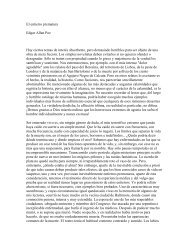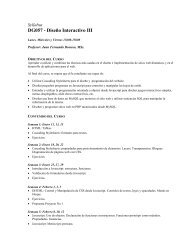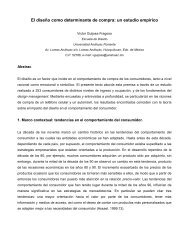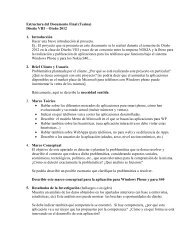descargar archivo - Departamento de Diseño - Universidad ...
descargar archivo - Departamento de Diseño - Universidad ...
descargar archivo - Departamento de Diseño - Universidad ...
You also want an ePaper? Increase the reach of your titles
YUMPU automatically turns print PDFs into web optimized ePapers that Google loves.
Diseño sin Fronterasmain objective of the research was to i<strong>de</strong>ntify how valuesare influenced by culture 1 . The book entitled ‘Culture´sConsequences’ – published in 1980, is the result of thisHofste<strong>de</strong> work.In 1991, Hofste<strong>de</strong> published the first edition of the book‘Cultures and Organizations: Software of the Mind’. In 2005,a new edition of this book was published with GeertHofste<strong>de</strong>´s son as co-author. Gert Jan Hofste<strong>de</strong>, has largeteaching experience on cultural aspects and he is authorof the book ‘Exploring Culture: exercises, stories and syntheticcultures’.The cultural dimensions proposed by the author 2 , resultedof studies in various environments, including the corporateas the one at IBM, has been used as reference and source inpapers and works in different areas of study, including theDesign, as we will present later.Hofste<strong>de</strong> & Hofste<strong>de</strong> say that societies differ from eachother by specific values, represented through six culturaldimensions.The first one regards the asymmetry in social relationsand evaluates hierarchical issues. With the name powerdistance, it refers ‘to the extent to which less powerfulmembers of an organization or institution (like the family)of a country accept and expect that power is distributedunequally.’ Among the 74 countries evaluated, the oneswith the highest levels of power distance were: Malaysia,Slovakia and Guatemala. The countries with the lowestlevels of Power Distance were: Denmark, Israel and Austria.(2005, p. 43-44).The second dimension was named individualism andcollectivism. It illustrates ‘the <strong>de</strong>gree to which individualsare integrated into groups’. The study pointed out thatmost of the societies are collectivist, where the interest ofthe group prevail the interest of oneself. A minority of thesocieties is individualist and consi<strong>de</strong>rs personal issues moreimportant than the interest of the group. (2005, p.76). TheUnited States, Australia and Great Britain were the countrieswith the highest levels of this dimension, being classified asindividualist cultures. Panama, Equator and Guatemala hadthe lowest levels and belong to more collectivist cultures(2005, p.78-79). Curiously, it was also pointed out that societieswith high level of power distance presented, also, highlevel of collectivism. On the other hand, societies with lowlevels of power distance were consi<strong>de</strong>red individualist.(Hofste<strong>de</strong> & Hofste<strong>de</strong>, 2005, p.82).1 The IBM research was replicated in other researches and, thus, it was possible to evaluate alarger number of countries and regions, a total of 74.2 Work introduced in the book ‘Culture´s Consequences’. (1980) and re-introduced in anotherpublication ‘Cultures and organizations: software of the mind’, in 1991, and in the the 2n<strong>de</strong>dition published in 2005 with Gert Jan Hofste<strong>de</strong> as co-author.The third dimension is called masculinity and femininityand it refers to the distributions of roles between thegen<strong>de</strong>rs:A society is called masculine when emotional gen<strong>de</strong>r roles are clearlydistinct: men are supposed to be assertive, tough, and focused onmaterial success, whereas women are supposed to be more mo<strong>de</strong>st,ten<strong>de</strong>r, and concerned with the quality of life. (Hofste<strong>de</strong> & Hofste<strong>de</strong>2005, p.120)Moreover, a society is consi<strong>de</strong>red feminine when roles andrelations between the gen<strong>de</strong>rs are more balanced: “bothmen and women are supposed to be mo<strong>de</strong>st, ten<strong>de</strong>r, andconcerned with the quality of life” (Hofste<strong>de</strong> & Hofste<strong>de</strong>,2005, p.120). Slovakia, Japan and Hungry had the highestlevels among the 74 countries evaluated and were classifiedas masculine cultures. The Netherlands, Norwayand Swe<strong>de</strong>n, countries with the lowest scores, representfeminine cultures (2005, p. 120).The fourth dimension is uncertainty avoidance. It correspondsto the societies’ tolerance to uncertainty andambiguity and it shows to what extent individuals feelthreaten and uncomfortable in uncertain or unknownsituations. The countries with the highest scores and thatpresent low tolerance to ambiguity and unusual situationsare: Greece, Portugal and Guatemala. The countries withthe lowest levels, cultures with weak uncertainty avoidanceare: Denmark, Jamaica and Singapore (Hofste<strong>de</strong> &Hofste<strong>de</strong>, 2005, p. 168)The fifth dimension is called long-term and short-termorientation. Societies with long-term orientation valueparsimony and perseverance. Short-term societies valuevirtues oriented to the past and the present such as:respect for traditions, protection of one´s face, and thefulfillment of social obligations (Hofste<strong>de</strong> & Hofste<strong>de</strong>, 2005,210). Among the 39 countries evaluated, China, Hong-Kongand Taiwan were evaluated as long-term cultures with thehighest levels of this dimension. Nigeria, Czech Republicand Pakistan were consi<strong>de</strong>red short-term cultures 3 .The sixth dimension is indulgence and constraint.Indulgence refers to societies that “allow relatively freegratification of basic and natural human drives relatedto enjoying life and having fun”. Furthermore, constraintillustrates the conviction of a society that gratificationsshould be suppressed and regulated by strict social norms(Hofste<strong>de</strong> et al. 2010, p.281).This dimension was recently formulated by Hofste<strong>de</strong> &Hofste<strong>de</strong> and it presents two poles: the first one indicatesthe high level of happiness and it concerns individualsthat look for fun and pleasurable activities, with no feelingof guilt; the second one regards those whose attitu<strong>de</strong>s3 Brazil was in the 7th position in the raking, indicating its long-term nature. Comparing withthe other dimensions, Brazil was not close to the higher level nor to the lower level.27
















